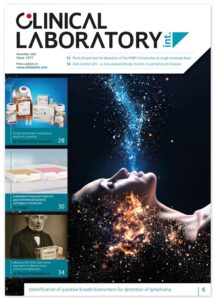Using ferritin as a biomarker for hemophagocytic lymphohistiocytosis can reduce delays in treatment due to negative or pending hemophagocytosis results
Using ferritin as a biomarker for hemophagocytic lymphohistiocytosis can reduce delays in treatment due to negative or pending hemophagocytosis results
Hemophagocytic lymphohistiocytosis (HLH) is a hyperinflammatory syndrome characterized by the overwhelming activation of normal T lymphocytes and macrophages with a very high mortality rate. There are two types of HLH: primary (or familial) HLH is a heterogeneous autosomal recessive disorder with an onset usually before the age of 1 year; secondary HLH (sHLH) occurs as the result of strong activation of the immune system following infection, immunodeficiency or malignancy. The patient’s best chance of survival depends on fast treatment with immunosuppressives. This relies on early recognition of sHLH, which is very similar to sepsis/septic shock in critically ill patients. Diagnosis of sHLH currently relies meeting at least five out of eight HLH-2004 criteria: fever, splenomegaly, bicytopenia, hypertriglyceridemia and/or hypofibrinogenemia, hemophagocytosis, low/absent NK-cell-activity, hyperferritinemia, and high-soluble interleukin-2-receptor levels. However, the HLH-2004 criteria were developed for pediatric patients and a high rate of undiagnosed sHLH cases has been seen in critically ill adult patients.
Read the research
Value of hemophagocytosis in the diagnosis of hemophagocytic lymphohistiocytosis in critically ill patients. Nyvlt P, Schuster FS, Ihlow J et al. Eur J Haematol 2024;112(6):917–926 (https://onlinelibrary.wiley.com/doi/10.1111/ejh.14185).
Determination of hemophagocytosis, which is often not seen in the early stages of the disease, requires invasive procedures such as bone marrow biopsy that are time consuming and may not be readily available in all institutions. Therefore waiting for bone marrow results may delay diagnosis and treatment, and contribute to the high mortality rate seen in these patients. Hence, Nyvlt et al. performed a secondary analysis of a retrospective observational study of 116 310 critically ill patients to investigate the value of hemophagocytosis as a criterium for the diagnosis of sHLH, and their results were published recently (Nyvlt P, Schuster FS, Ihlow J et al. Value of hemophagocytosis in the diagnosis of hemophagocytic lymphohistiocytosis in critically ill patients. Eur J Haematol 2024;112(6):917–926 [1]). Their findings were that although hemophagocytosis analysis showed best discrimination between HLH and non-HLH patients, but that removal of hemophagocytosis from the HLH-2004 criteria and the HScore only marginally decreased prediction accuracy for HLH diagnosis compared to the original scores. They found that a maximum ferritin level of 9775 ug/L was suggestive of hemophagocytosis. They state that “Our results strengthen the diagnostic value of ferritin and underline the importance of considering HLH diagnosis in patients with high ferritin but only four fulfilled HLH-2004 criteria, when hemophagocytosis was not assessed or not detectable” and that “[p]roof of hemophagocytosis is not required for a reliable HLH diagnosis”. This is good news for increasing the speed with which a diagnosis of sHLH can be made and life-saving treatment begun.





